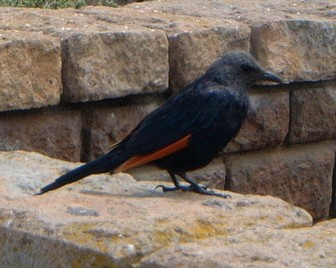Red-winged Starling
The Red-winged Starling builds a lined nest of grass and twigs, and with a mud base, on a natural or structural ledge. It lays 2–4, usually three, blue eggs, spotted with red-brown. The female incubates the eggs for 13–14 days, with another 22–28 days to hatching. This starling is commonly double-brooded. It may be parasitised by the Great Spotted Cuckoo.

Original source: Transferred from en.wikipedia; transferred to Commons by User:Snowmanradio using CommonsHelper.
Author: Original uploader was Jimfbleak at en.wikipedia
Permission: GNU Free Documentation License
The Red-winged Starling is classified as Least Concern. Does not qualify for a more at risk category. Widespread and abundant taxa are included in this category.
Red-winged Starling spotted in Jurong - Posted by BESG on 3 February 09, Tuesday Contributed by Choo Teik Ju A Red-winged Starling (Onychognathus morio) was spotted at Jurong Lake Park by Choo Teik Ju a.k.a choo in early December 2008. Teik Ju initially thought it was a crow but then the bill was not as thick as the crow’s. More
The Red-winged Starling builds a nest of grass on a ledge in a sheltered site such as a cave. It is also associated with human settlement, and some related red-winged starling species are known to use man-made structures as nest sites. This species is territorial, aggressive and intolerant when nesting, and will attack other species, including birds of prey. Like other starlings, the Neumann's Red-winged Starling is an omnivore, taking a wide range of fruit, including figs, and some invertebrates. More
The Red-winged Starling, Onychognathus morio, is a bird native to eastern Africa from Ethiopia to the Cape in South Africa. Originally breeding mainly on rocky cliffs, outcrops and gorges, it is now common in urban areas, using buildings and other man-made structures as nest sites. The Red-winged Starling builds a lined nest of grass and twigs, and with a mud base, on a natural or structural ledge. It lays 2–4, usually three, blue eggs, spotted with red-brown. More
Red-winged starling female, World of Birds, Hout Bay. Red-winged starling male, Kirstenbosch Botanical Gardens, South Africa. Distribution and habitat Occurs in patches from Ethiopia through Kenya, Tanzania and Malawi to southern Africa. Here it is common from northern Mozambique and Zimbabwe to eastern Botswana and South Africa (as well as Lesotho and Swaziland), while absent from the Karoo and Kalahari. More
For the purposes of our bird news services, Red-winged Starling is classed as ungraded: species which are unlikely to appear as wild birds in Britain or Ireland (Note that rarity levels are currently applied nationally and may not reflect local variations in abundance. More
The bill of the Red-winged Starling is short, and slightly arched. The bill, legs and feet are black. The eye is dark red. The male Red-winged Starling is mostly a dark glossy blue-black, while the female is duller with a grey head extending to grey streaking on the upper breast and mantle. Both male and female have distinctive chestnut primaries, which are visible at rest, but very obvious in flight - appearing a large red-brown patch in the flight feathers. More
Side view of a Red-Winged Starling in mid-flight and flying away from a lichen-covered rock. The wings are held low showing chestnut primary feathers, glossy body plumage and broad, blunt-ended tail. More
Red-winged Starlings nest on ledges and, despite being aggressive towards other birds, they may nest in small colonies. They regularly mob predators such as the African Harrier-Hawk. More
a picture of the Red-winged Starling on page 976. The Red-winged Starling belongs to the family of birds classified as Sturnidae. According to the Percy FitzPatrick Institute of African Ornithology the Red-winged Starling is also known by these other names: African Red-winged Starling, Crag Chestnut-winged Starling. The map of the Kruger you see on this page shows the areas (coloured orange) where this bird has been identified. More
The Red-winged Starling is the 9th in the series of the birds of the Kruger National Park, which I am currently sharing. Enjoy! I remember the day I took this photo as good as if it was yesterday. It was a very hot day and we decided to have a midday rest at the bungalow to avoid the terrible heat we where experiencing that day. More

Original source: Kevin Rolle
Author: Kevin Rolle
Permission: Some rights reserved
Family : Sturnidae
Genus : Onychognathus
Species : morio
Authority : (Linnaeus, 1766)

